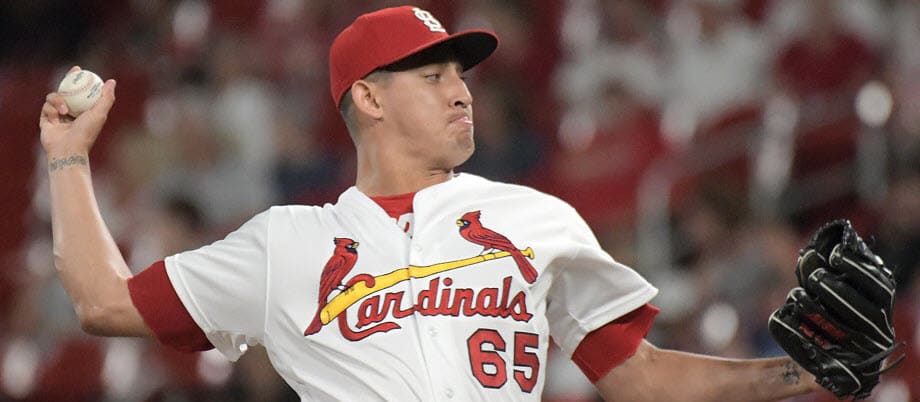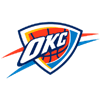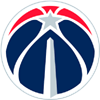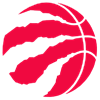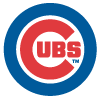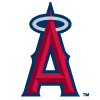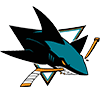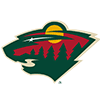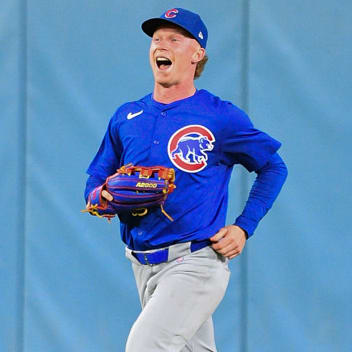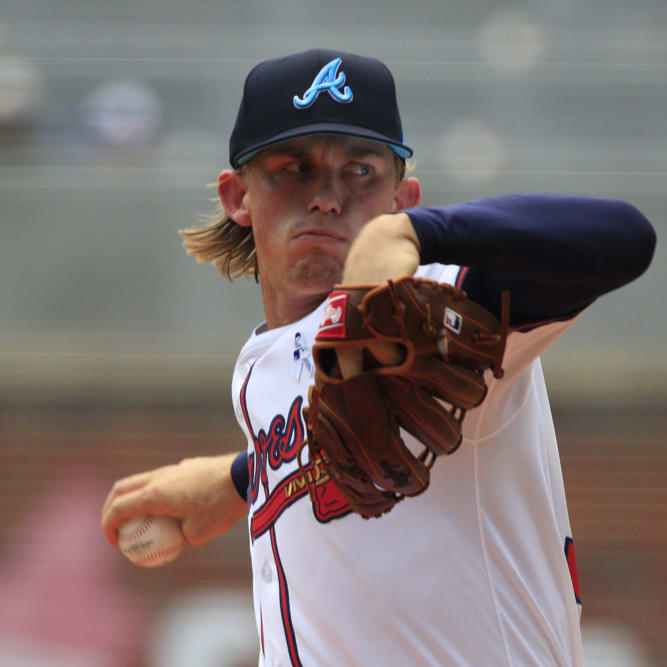One of the many features of our MLB closer grid are my Closer in Waiting Rankings.
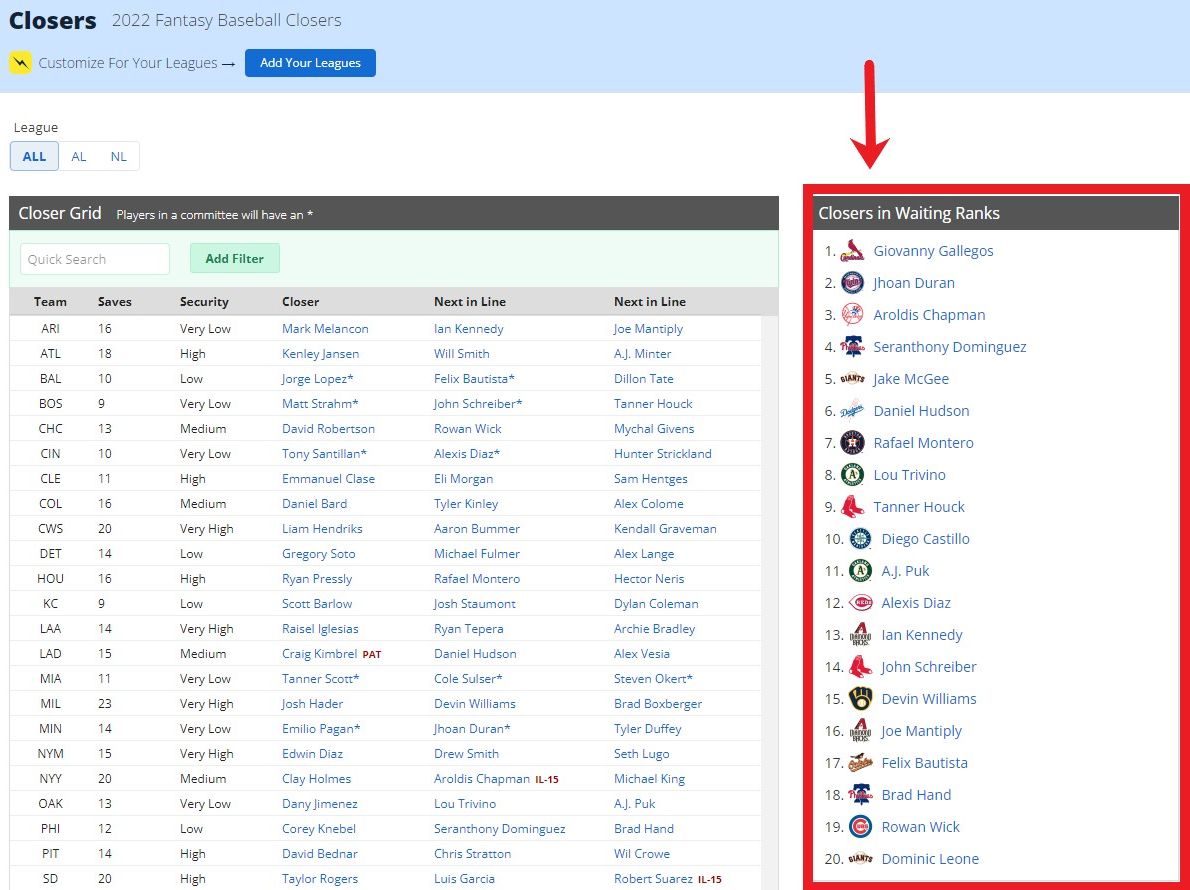
I get questions on these rankings all the time. Since they are subjective and not formulaic, I thought it might be helpful to explain my thought process for this ranking exercise. There are several questions I ask myself when determining who to rank and where to rank each pitcher.
- How is the incumbent or primary closer performing? Are they struggling? If struggles are not evident within their surface stats, are there concerns within their underlying metrics that may soon come to light? Hansel Robles recently returned from the injured list after dealing with a back injury, but is a prime example of a pitcher whose surface stats look respectable thanks to a 0.95 WHP, two saves and seven holds. However, his 2.37 ERA far outperforms his 4.66 FIP and his .176 BABIP is bound to regress. Robles' 1.4 HR/9 and 18.9 percent strikeout rate (the lowest of his career) suggest he's bound to come back to Earth at some point.
- What is the team context? Are they part of a winning organization whose chances of making the playoffs are high, or are they a rebuilding club?
- How is the team performing lately? Are they giving their bullpen the opportunity to close out games with a lead? One recent example is the Miami Marlins, who went 7-19 in May and only tallied one save as a team during the entire month.
- What are the team's
One of the many features of our MLB closer grid are my Closer in Waiting Rankings.

I get questions on these rankings all the time. Since they are subjective and not formulaic, I thought it might be helpful to explain my thought process for this ranking exercise. There are several questions I ask myself when determining who to rank and where to rank each pitcher.
- How is the incumbent or primary closer performing? Are they struggling? If struggles are not evident within their surface stats, are there concerns within their underlying metrics that may soon come to light? Hansel Robles recently returned from the injured list after dealing with a back injury, but is a prime example of a pitcher whose surface stats look respectable thanks to a 0.95 WHP, two saves and seven holds. However, his 2.37 ERA far outperforms his 4.66 FIP and his .176 BABIP is bound to regress. Robles' 1.4 HR/9 and 18.9 percent strikeout rate (the lowest of his career) suggest he's bound to come back to Earth at some point.
- What is the team context? Are they part of a winning organization whose chances of making the playoffs are high, or are they a rebuilding club?
- How is the team performing lately? Are they giving their bullpen the opportunity to close out games with a lead? One recent example is the Miami Marlins, who went 7-19 in May and only tallied one save as a team during the entire month.
- What are the team's recent late inning usage patterns? Giovanny Gallegos and Camilo Doval recently appeared in the sixth inning for their respective teams, which forced me to dive deeper into usage patterns for St. Louis and San Francisco and make adjustments to their closer hierarchies.
- What is contract status of the relievers in this bullpen? Which pitchers are upcoming free-agents? Who might be on the movie at the trade deadline this summer? Who is within or is approaching salary arbitration? The latter is particularly important for relievers on cost conscious teams, as it may limit the number of save opportunities one receives as to prevent them from becoming too costly. David Robertson and Corey Knebel are two experienced relievers on one-year deals for their respective clubs. If Chicago and Philadelphia fall out of the playoff race by mid-to-late July, both are likely to be traded to contenders.
Now that you have an idea of where my head is at, one of the primary factors I consider when ranking closers in waiting is a pitcher's likelihood of stepping into a full-time closer role. I previously had Devin Williams ranked highly due to his massive upside. The more I thought about it, his chances of overtaking Josh Hader as the primary closer in Milwaukee are incredibly slim. Hader has been 2022's most dominant closer to date and unless he gets hurt or the Brewers trade him, the latter of which is highly unlikely given they are currently in a tight race with the Cardinals for the NL Central division lead, Williams should maintain his setup role while providing ancillary save support when Hader is unavailable. Williams already has four saves and two wins through early June, so he still warrants a ranking, but Hader's high security in the closer role affects where I have him ranked.
Potential fantasy impact is another consideration. Jhoan Duran is already contributing positively to fantasy teams thanks to his impressive ratios and strikeout rate, but imagine if he fully took over Minnesota's closer role. He'd likely become one of the most valuable closers for fantasy purposes. Emilio Pagan tallied five saves last month to Duran's four, but Pagan's elevated home run (2.3 HR/9) and walk rate (12.6 percent) may eventually force Twins manager Rocco Baldelli to remove him from ninth inning consideration moving forward.
In scenarios where there is a closer committee or time share, I still try to view things as if there's a primary option for saves (1A) and secondary option(s) (1B, C, etc.). Anyone who - in my opinion - is still a secondary option for saves would still be listed in the closer in waiting rankings. Of course, my opinion may not align with yours, which is where the subjectivity of these rankings comes into play.
So let's dive into my updated Closer in Waiting Rankings as of June 8:

 Giovanny Gallegos, Cardinals - I recently swapped Gallegos and Ryan Helsley's placement on the closer grid, with the latter overtaking the 'primary' spot based on manager Oliver Marmol's recent usage of the two relievers:
Giovanny Gallegos, Cardinals - I recently swapped Gallegos and Ryan Helsley's placement on the closer grid, with the latter overtaking the 'primary' spot based on manager Oliver Marmol's recent usage of the two relievers:
Giovanny Gallegos - Last 8 Games | |||||||
|---|---|---|---|---|---|---|---|
Date | Inning Entered / Left | Result | IP | H | ER | BB | K |
June 10 | 8th / 8th | H (2) | 1.0 | 0 | 0 | 3 | 1 |
June 7 | 8th / 8th | n/a | 1.0 | 0 | 0 | 0 | 1 |
June 4 | 9th / 10th (Finished Game) | W (1-2) | 2.0 | 2 | 0 | 1 | 5 |
May 31 | 8th / 8th | BS (3) | 1.0 | 2 | 2 | 0 | 2 |
May 30 | 6th / 7th | H (1) | 1.0 | 2 | 0 | 0 | 2 |
May 26 | 9th / Finished Game | n/a | 1.0 | 0 | 0 | 0 | 2 |
May 23 | 8th / 8th | n/a | 1.0 | 0 | 0 | 0 | 0 |
May 20 | 8th / Finished Game | SV (8) | 1.2 | 0 | 0 | 0 | 5 |
Ryan Helsley - Last 8 Games | |||||||
|---|---|---|---|---|---|---|---|
Date | Inning Entered / Left | Result | IP | H | ER | BB | K |
June 10 | 9th / Finished Game | SV (4) | 1.0 | 0 | 0 | 0 | 2 |
June 7 | 9th / 9th | n/a | 1.0 | 0 | 0 | 1 | 0 |
June 4 | 6th / 8th | BS (2) | 2.2 | 2 | 0 | 0 | 2 |
May 31 | 9th / 9th | n/a | 1.0 | 0 | 0 | 1 | 0 |
May 30 | 8th / Finished Game | n/a | 1.1 | 2 | 1 | 1 | 1 |
May 27 | 9th / Finished Game | SV (3) | 0.2 | 0 | 0 | 0 | 1 |
May 23 | 9th / 9th | n/a | 1.0 | 0 | 0 | 1 | 1 |
May 21 | 9th / Finished Game | SV (2) | 1.0 | 0 | 0 | 0 | 1 |
To summarize the above, six of Helsley's last eight appearances have come in the ninth inning, with three saves during that span. Meanwhile, Gallegos has only pitched the ninth inning twice in his last eight outings, with only one save. Ironically, this save came after he entered the game in the eighth inning and closed out the final 1.2 innings. Gallegos has often been summoned to face the bottom half of the opposing team's lineup. Despite the recent shift in Helsley's favor, Gallegos has actually been the better pitcher of late, which makes this situation fascinating to monitor. Last month, Gallegos tallied four saves to Helsley's three. I anticipate the save distribution in June will shake out similarly, with Helsley possibly earning a few more save chances if his usage pattern in the ninth inning continues.
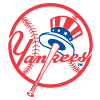 Aroldis Chapman, Yankees - Based on our latest update, Chapman (Achilles) is reportedly pain-free but does not have a timetable to return. However, the southpaw has been keeping his upper body in shape while on the IL and manager Aaron Boone indicated he's scheduled throw a bullpen session Saturday. It's not clear at this time whether Chapman will require a rehab assignment. The veteran's performance this season has been spotty - his 1.64 WHIP, 22.7 strikeout rate and 97.2 mph average fastball velocity are career worsts, while his 15.2 percent walk rate is nearly the worst of his career. Chapman isn't guaranteed to reclaim the Yankees' closer role upon his return, especially since Clay Holmes has pitched so well in his absence. Holmes has racked up nine saves through early June and has 26 consecutive scoreless outings, spanning 28 innings. Despite Holmes' success, I agree with my fellow northeast Ohioan, Dave McDonald's, opinion below:
Aroldis Chapman, Yankees - Based on our latest update, Chapman (Achilles) is reportedly pain-free but does not have a timetable to return. However, the southpaw has been keeping his upper body in shape while on the IL and manager Aaron Boone indicated he's scheduled throw a bullpen session Saturday. It's not clear at this time whether Chapman will require a rehab assignment. The veteran's performance this season has been spotty - his 1.64 WHIP, 22.7 strikeout rate and 97.2 mph average fastball velocity are career worsts, while his 15.2 percent walk rate is nearly the worst of his career. Chapman isn't guaranteed to reclaim the Yankees' closer role upon his return, especially since Clay Holmes has pitched so well in his absence. Holmes has racked up nine saves through early June and has 26 consecutive scoreless outings, spanning 28 innings. Despite Holmes' success, I agree with my fellow northeast Ohioan, Dave McDonald's, opinion below:
I still think if Aroldis Chapman figures out his mechanics he'll be back closing for the Yankees. It doesn't matter that Holmes is better, they prefer him in the fireman role with Aroldis closing. Chapman has lost his job several times last couple years.. Always gets it back
— Less than Dave (@RunDMcD) June 8, 2022
The last time Chapman wasn't a primary closer was back in 2011 while with Cincinnati. He also endured a far worse rough patch over an extended period last season and rebounded to finish the year strong. That gives me confidence he can turn his season around and reclaim his role upon his return, with Holmes still pitching in for ancillary saves, similar to Chad Green and Jonathan Loaisiga last year. Chapman is in the final year of his contract with the Yankees. If he doesn't return to New York in 2023, he will likely want to end his six-and-a-half year run with the club on a high note. I expect that to be as the Yankees closer, whether that's the correct baseball decision or not.
 Jake McGee, Giants - The Giants bullpen posted a league-worst 6.26 ERA in May and kicked off June with another rough week thanks to a 5.33 ERA. Fortunately, the recent return of Jake McGee may provide this team a spark after the southpaw briefly spent time on the IL with lower-back tightness. Since his return from the injured list, McGee is displaying increased velocity. During a recent appearance on June 10 McGee's fastball averaged 95.7 miles per hour while topping out at 96.7 miles per hour. That's a notable improvement on his 94.5 mph season average and it has yielded better results. After tallying 31 saves for the Giants last season, McGee could easily slide back into a ninth inning duties in place of Camilo Doval, who has been summoned in the sixth inning in two of five appearances this month.
Jake McGee, Giants - The Giants bullpen posted a league-worst 6.26 ERA in May and kicked off June with another rough week thanks to a 5.33 ERA. Fortunately, the recent return of Jake McGee may provide this team a spark after the southpaw briefly spent time on the IL with lower-back tightness. Since his return from the injured list, McGee is displaying increased velocity. During a recent appearance on June 10 McGee's fastball averaged 95.7 miles per hour while topping out at 96.7 miles per hour. That's a notable improvement on his 94.5 mph season average and it has yielded better results. After tallying 31 saves for the Giants last season, McGee could easily slide back into a ninth inning duties in place of Camilo Doval, who has been summoned in the sixth inning in two of five appearances this month.
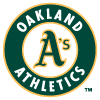 Lou Trivino, A.J. Puk, Athletics - Dany Jimenez is losing his grip on the closer role in Oakland. He's allowed 11 earned runs over his last five appearances (3.2 innings), with two blown saves and three losses over that span. Meanwhile, Lou Trivino has an impressive 16:3 K:BB ratio over his last 8.2 innings. It's a small sample, but that equates to a 16.6 K/9, the third-highest ratio in the league among qualified relievers since May 13. Trivino has two years of salary arbitration remaining and already makes $3 million for the cost conscious A's. Despite some recent hiccups, I think it's likely that Oakland re-inserts Trivino back to the closer role in the near future in an attempt to build his trade value for later this summer. Another candidate to replace Jimenez as Oakland's closer is A.J. Puk, who sports excellent ratios despite allowing an earned run in four of his last six outings. Puk may be the desired closer in waiting for Oakland fans, but from a baseball standpoint, I think Trivino has a better chance of replacing Jimenez.
Lou Trivino, A.J. Puk, Athletics - Dany Jimenez is losing his grip on the closer role in Oakland. He's allowed 11 earned runs over his last five appearances (3.2 innings), with two blown saves and three losses over that span. Meanwhile, Lou Trivino has an impressive 16:3 K:BB ratio over his last 8.2 innings. It's a small sample, but that equates to a 16.6 K/9, the third-highest ratio in the league among qualified relievers since May 13. Trivino has two years of salary arbitration remaining and already makes $3 million for the cost conscious A's. Despite some recent hiccups, I think it's likely that Oakland re-inserts Trivino back to the closer role in the near future in an attempt to build his trade value for later this summer. Another candidate to replace Jimenez as Oakland's closer is A.J. Puk, who sports excellent ratios despite allowing an earned run in four of his last six outings. Puk may be the desired closer in waiting for Oakland fans, but from a baseball standpoint, I think Trivino has a better chance of replacing Jimenez.
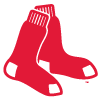 Tanner Houck, Red Sox - Houck escaped a late-inning jam and pitched two scoreless innings against the Angels on Tuesday, then secured his first save of the season at Seattle on Friday. Manager Alex Cora confirmed after Tuesday's game that he intends to use the right-hander in high leverage situations moving forward, similar to the way he deployed Garret Whitlock last year. Houck will no longer serve as a piggyback starter, instead pitching two-inning stints at maximum. Houck's new high leverage role may be a much-needed spark for a bullpen that has struggled to hold leads all season. Boston recently welcomed Hansel Robles from the IL, but Houck and lefty Matt Strahm appear to be Cora's primary options for saves, with John Schreiber also in the mix.
Tanner Houck, Red Sox - Houck escaped a late-inning jam and pitched two scoreless innings against the Angels on Tuesday, then secured his first save of the season at Seattle on Friday. Manager Alex Cora confirmed after Tuesday's game that he intends to use the right-hander in high leverage situations moving forward, similar to the way he deployed Garret Whitlock last year. Houck will no longer serve as a piggyback starter, instead pitching two-inning stints at maximum. Houck's new high leverage role may be a much-needed spark for a bullpen that has struggled to hold leads all season. Boston recently welcomed Hansel Robles from the IL, but Houck and lefty Matt Strahm appear to be Cora's primary options for saves, with John Schreiber also in the mix.


